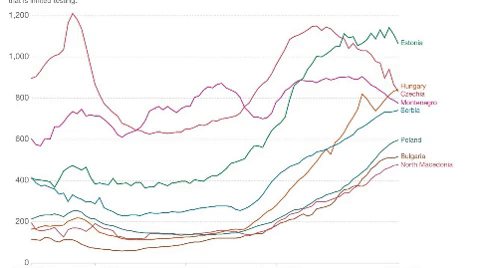Where is COVID-19's 'third wave' hitting Europe?
We Europeans can't say we weren't warned. The third wave of the COVID-19 pandemic has been predicted since last summer's easing of restrictions led to a second spike that was much higher than the first, in the far-off days of spring 2020.
But where is the third wave landing in Europe now? With each country taking different measures to combat COVID-19, the rates of infection vary across the continent.
Here, CGTN Europe examines the numbers, presented by Our World In Data using information from Johns Hopkins University, to try to answer that question.
Firstly, some data housekeeping. The best metric to use is the number of new cases each country reports per day – and to make comparisons fair, per million population. We've also excluded some very small countries (under 250,000 population) as their small sample set can produce outliers.
Under that definition, which European countries have the current highest infection rates?
The top eight
In very simple terms, the answer to the headline question is: Eastern Europe… for now. While scholars have long disagreed what 'Eastern Europe' actually means, it's unarguable that the top eight countries are all further east than Madrid, Manchester, Milan or Munich.
The worst-hit European country right now is Estonia, with 1067.01 new cases per million every day since March 5. On its way down from a similar height (and worse: it hit 1,209.72 on January 10), Czechia is now glad to be back down at 834.76.
That takes it fractionally below the 842.93 of Hungary, where Prime Minister Viktor Orban split from the EU's centralized vaccination program by buying in Sputnik-V jabs from Russia and Sinopharm from China.
Even so, referring back to the first graph shows that Hungary's new case totals are growing, and not in isolation: Serbia (740.26), Poland (596.20), Bulgaria (517.55) and North Macedonia (467.77), like Hungary, have all doubled since late February or even early March. Of the current top eight, only Montenegro (776.99) is going in the right direction – and even then only after a rollercoaster couple of months.
What about vaccinations?
By February 28, when Orban posted a picture of himself with a syringe in his arm, Serbia, being outside the EU, had already sourced vaccines from far and wide: Prime Minister Ana Brnabic was the first European leader to receive the Pfizer-BioNTech vaccine, the internal affairs minister took the Sputnik-V and the health minister posed for photographs taking the Sinopharm shot.
But this freedom of choice hasn't helped the reliability of the roll-out. On February 17, Serbia vaccinated 0.95 percent of its 8.7m population in one day, but by March 3 that was down to 0.4 percent. While EU members are understandably keen to correct distribution problems, it seems that even a regular supply chain won't necessarily stop numbers climbing – yet.
The big five
The five great nations at the center of European affairs – even if in one case its citizens chose to leave the EU – have had different experiences in 2021.
The UK and Spain have recovered well from huge spikes in January. The UK has dropped from 881.31 on January 9 to around 80 two months later, while Spain has come down from 791.59 on January 26 to hover around the 100 mark for the past two weeks.
While the UK's case-rate plummet can be credited to a huge vaccination program, Spain's similar drop has come with vaccination at a broadly similar rate – rising, but not very swiftly – to France, Germany and Italy.
Those last three countries have spent 2021 attempting to hold back the next wave, with varying success. After holding steady around the 300 mark, France has now nudged over 400 new cases per day, with Italy just below it, while Germany is wracked by political arguments over lockdown.
Germany's new-case rate was as low as 85.37 on February 14 but inexorably rose again. On March 10 it burst through the 100 new cases per million benchmark, and only eight days later topped 150.
Looking briefly at the longer term, it's worth noting that over the year of the pandemic, Germany's daily rate has been much worse before, topping 300 new cases for each of the four days before Christmas (peak 307.42 on Dec 23). That peak was low compared with other big European countries such as the UK's 881.31 on January 9, France's 825.05 on November 3, Spain's 791.59 on January 26 and Italy's 580.08 on November 16.
Where could I go on summer holiday?
Let's face it, after the year we've had we could all use a nice relaxing break on the beach. But what about that incoming wave? It's instructive to look at eight popular European destinations.
For this chart we've reduced the timespan to start at February 12, mainly because previous case rates in Portugal and Spain were much higher, condensing the chart. Those two Iberian destinations are still tracking downwards, which is good news for their tourism industry and all those who may wish to take part in it.
Sadly, the same isn't true elsewhere in the Mediterranean. Greece, Turkey and Croatia have been marching upward in lockstep, with Greece's current rate of 254.35 having doubled since February 23 and Turkey's 253.87 having doubled since March 5 – the same time frame in which Croatia's 239.41 has doubled.
Cyprus has got worse even faster, rocketing from 124.77 on February 22 to 341.69 on March 4 – leading this particular selection of nations – and on March 14 reached what we must hope was a peak of 452.57.
What about the Nordics?
As debate raged about how best to confront COVID-19, much was made of the fundamental difference between the actions of Scandinavian neighbors Sweden and Norway: Laissez-faire or lockdown? While those differences have since reduced, with Sweden tightening up, it's still interesting to compare the countries.
Sadly for Sweden, its case rate is still much higher. After peaking at 736.86 in the second week of January, the rate fell under 300 for the first half of February but is rising again and currently stands at 467.44.
That's about three times the level of neighbors Norway (175.63), Denmark (127.98) and Finland (125.36), although all three are above the 100 benchmark. (For the record, all four are vaccinating at roughly the same rate, accelerating from around 0.15 per day per 100 people at the end of January to 0.3 by mid-March).
Is there any good news?
Any league table has its top teams and its bottom teams. Here are the eight European countries with the lowest current case rates, from Belarus (125.91) down to Iceland (14.65).
The chart is a little difficult to read at the most recent end, but that's because the numbers are so small compared with previous peaks. We've left it like that as a visible tribute to the effectiveness of measures carried out in countries like Ireland (peaking at 1,322.91 on January 10), the UK (881.31 the previous day), Portugal (1,264.19 on January 28) and Spain (791.59 on January 26).
It's a reminder that however bad the situation may seem, things can change, and even the worst peaks can fall. The third wave will not hit Europe uniformly, but with effective vaccine distribution and the correct, if agonizing, decisions made over restrictions, hopefully Europe can muster its own wave for COVID-19: A wave goodbye.
Originally published by CGTN on 25 March 2021












